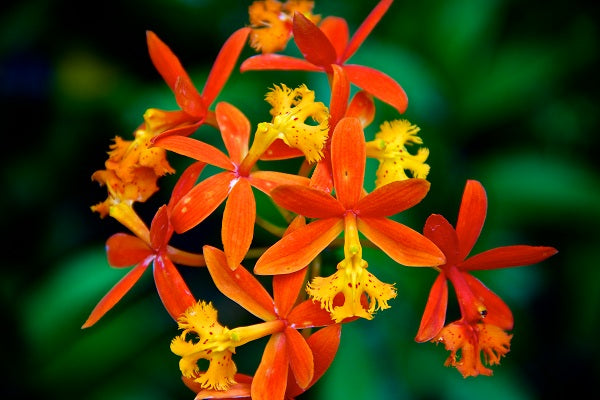Fast Facts Epidendrum Orchids
Botanical Name: Epidendrum (E-pee-DEN-drum)
Abbreviation: Epi.
Etymology of the orchid genus' name: Greek, meaning “upon trees”
Family: Orchidaceae
Subfamily: Epidendroideae
Tribe: Epidendreae
Subtribe: Laeliinae
Number of recognized species: 1,000 to 1,483 recognized orchid species, depending on the source
Type species: Epidendrum nocturnum Jacq. 1763
Origin: Tropical America, from Florida, North Carolina, to Argentina, Mexico, Brazil.
Growing classification: Epiphytic and terrestrial
Blooming season: All seasons, mostly spring to summer
Color: With over 1,000 unique species, Epidendrum orchid blooms can come in a rainbow of vibrant colors. The most common ones include yellow, purple, pink, red, and white orchid flowers.
Orchid Origin
The Epidendrum orchid genus was first established by the Father of Modern Taxonomy, Carl Linnaeus, in 1745 in an effort to create a group for all recognized epiphytic orchids during his time. They can be found in most tropical America, including countries such as Brazil, Mexico, and Argentina, at every elevation in the Andes and mountains of Central America.
Epiphytic or terrestrial in growth, Epidendrum orchids can be found attached to trees in cold cloud forests, on trunks of trees in swamp forests, or on forest floors. They are pollinated by butterflies or hummingbirds in nature.
Epidendrum Plant Description
The American Orchid Society describes orchid plants in the Epidendrum genus with “column fused with lip entire length, rostellum formed by a blade that produces semiliquid visidium, which when removed leaves a cleft in the rostellum.”
Most orchids from this genus have characteristically long, cane-like pseudobulbs filled with alternating foliage. Flowers are usually tiny, thin and in clusters, although there are several showy varieties as well.
Epidendrum orchids are quite diverse. There are some orchid plants that grow up to six feet in height, such as the Epidendrum pfavii, and there are also miniature orchids, such as the Epidendrum porpax and Epidendrum sophronitoides.
Blooming in different seasons, but mostly spring to summer, Epidendrum orchids produce striking flowers in vibrant shades, including magenta, red, orange, and green. Unfortunately, there are no true blue or black orchids in the Epidendrum genus.
Types of Epidendrum Orchids
According to the book Ortho’s All About Orchids by Elvin McDonald, there are two main types of Epidendrum orchid species:
-
Epidendrum orchids with reed stems
These reed-stemmed Epidendrum orchids have a reputation for being constant flowering plants. This is why they are very rewarding to grow and make excellent cut flower orchids for orchid arrangements.
However, they can grow really tall and require ample amount of sunshine, high humidity, and generous watering. They’re not ideal as indoor orchid plants but will thrive gorgeously in your greenhouse or outdoor garden. Examples Epidendrum ibaguense and Epidendrum cinnabarimum. -
Epidendrum orchids with pseudobulbs
Pseudobulb-type Epidendrum orchids, on the other hand, go into a period of orchid dormancy for a few weeks after it has bloomed.
They need good air circulation and do well in 60 to 80 percent of humidity. Water copiously and frequently while it’s growing, especially during warm months. Space out watering sessions a bit for about three weeks to force prolific production of orchid blooms. Examples are Epidendrum radicans and Epidendrum obrienianum
However, it’s important to consider that there are also several types of Epidendrum orchids that do not belong to the two groups above.
Epidendrum Orchid Species
In the beginning, the Epidendrum orchid genus was based on Epidendrum nodosum, which was later on re-classified and moved to Brassavola. Interestingly, the AOS says that none of the original orchid species that pioneered the Epidendrum orchid genus remains in it.
Based on OrchidSpecies.com, the type species for this genus is currently Epidendrum nocturnum Jacq. 1763. Check out these important Epidendrum orchid species.
- Epidendrum abbottiiSánchez & Hágsater
- Epidendrum stamfordianumBateman
- Epidendrum oraionHágsater
- Epidendrum ibaguenseKunth
- Epidendrum ferrugineumRuiz & Pav.
- Epidendrum pseudepidendrumf., Xenia Orchid
- Epidendrum aberrans, Repert
- Epidendrum ackermaniiHágsater
- Epidendrum acreense(Brieger & Bicalho) Christenson
- Epidendrum acroamparoanumHágsater & L.Sánchez
- Epidendrum acrobatesiiHágsater & Dodson
- Epidendrum acrorhodumHágsater & Dodson
- Epidendrum acroscopeumHágsater & Dodson
- Epidendrum actinoglossumHágsater & E.Santiago
- Epidendrum acuminatumRuiz & Pav
- Epidendrum acunaeDressler
- Epidendrum acutissimum, Fol.
- Epidendrum adamsiiHágsater & Dodson
- Epidendrum addaePabst, Bradea
- Epidendrum adenoglossum, J. Bot. (Hooker)
- Epidendrum adnatumAmes & C.Schweinf
- Epidendrum adolfomorenoiVásquez & Ibisch,
- Epidendrum adsettiiSerracín, J.S.Harrison, Bogarín & Sánchez
- Epidendrum aenigmaticumHágsater & Dodson
- Epidendrum agathosmicumf., Linnaea
- Epidendrum aggregatum, J. Bot. (Hooker)
- Epidendrum carnevalii Hágsater & L.Sánchez,
- Epidendrum dunstervilleorum Foldats,
- Epidendrum foldatsii Hágsater & Carnevali
- Epidendrum garayi Løjtnant
- Epidendrum garciae Pabst
- Epidendrum hagsateri Christenson
- Epidendrum lueri Dodson & Hágsater
- Epidendrum schlechterianum Ames
- Epidendrum schweinfurthianum Correll
- Epidendrum incahuamanii Collantes & Hágsater
- Epidendrum incomptoides Ames, F.T.Hubb. & C.Schweinf. 1935
- Epidendrum kerichilum Hágsater 1988
- Epidendrum laeve Lindley 1844
- Epidendrum lagenocolumna Hágsater & L.Sánchez 1993
- Epidendrum lasiostachyum Rodr.-Mart., Hágsater & E.Santiago 2016
- Epidendrum laxifoliatum Schltr. 1920
- Epidendrum lehmannii Rchb.f. 1878
- Epidendrum leonorae Hagsater, O. Perez and E. Santiago 2013
- Epidendrum lilijae Foldats 1968
- Epidendrum marcapatense Hágsater & Ric.Fernández 2007
- Epidendrum marsiorum R.Vásquez & Ibisch 2003
- Epidendrum martinezii L.Sánchez & Carnevali 2001
- Epidendrum matudae L.O.Williams 1968
Notable Epidendrum Cultivars and Hybrids
Because of their low-maintenance nature and rewarding orchid blooms, Epidendrum orchids have been propagated and crossed between other orchid species from different genera. Some of the noteworthy cultivars and hybrids include:
- Epidendrum ‘Emerald Star’
- Epidendrum Hokulea ‘Tom Wilson’
- Epidendrum ilense ‘Lil’
- Epidendrum Nursery rhyme
- Epidendrum Plastic doll ‘Lil’
- Epidendrum ‘Harford’
- Epidendrum Tammy Virgen
- Epidendrum Traci Sellers
- Epicattleya Isler’s Goldgreen
- Epicattleya Rene Marques ‘Happy Harry’
- Epicattleya Princess Hitachi
- Epilaelia Cinnamatica
- Epilaelia Florence Rogers
- Epilaeliocattleya Merry Green
Epidendrum Orchid Care Tips
Epidendrum orchids are highly recommended for beginning orchid growers because of their fuss-free maintenance needs. If you want to try your luck growing these exquisite orchid plants in Los Angeles, follow these useful tips.
- Most Epidendrum orchids grow well in any type of well-draining soil or soilless medium. They can tolerate fine-grade fir bark, tree fern, or a mixture of charcoal, peat, perlite, and coconut fiber.
- You’ll be more successful growing Epidendrum orchid plants outside in your garden or balcony rather than in a south-facing window. These orchids are a sucker for sunshine.
- Allow your orchid plant’s root to dry completely in between watering days. When your orchid is new, observe for a couple of weeks how many days it take for the root to dry. Create a regular watering schedule out of it. This prevents instances of overwatering and underwatering.
- Epidendrum is a tropical orchid, which means it’s used to a hot, wet growing season and a dry, colder blooming season. To simulate this, water more frequently in the summer and then decrease later in the year.
- Lastly, do your research and study your orchid plant’s specific growing requirements. As any big orchid genus, Epidendrum orchid plants can have varying needs, depending on a whole host of different factors – including the country of origin, the natural habitat, or the climate it’s used to.
Suddenly inspired to go on an orchid shopping spree? Drop by our Sherman Oaks store to see our colorful collection of exquisite orchid plants and stylish orchid arrangements. You can also order online and have your orchids conveniently delivered the same day anywhere in Los Angeles and Orange County.
YOU MIGHT ALSO LIKE:
------------------------------------------------------------------------------------------------------------



Leave a comment